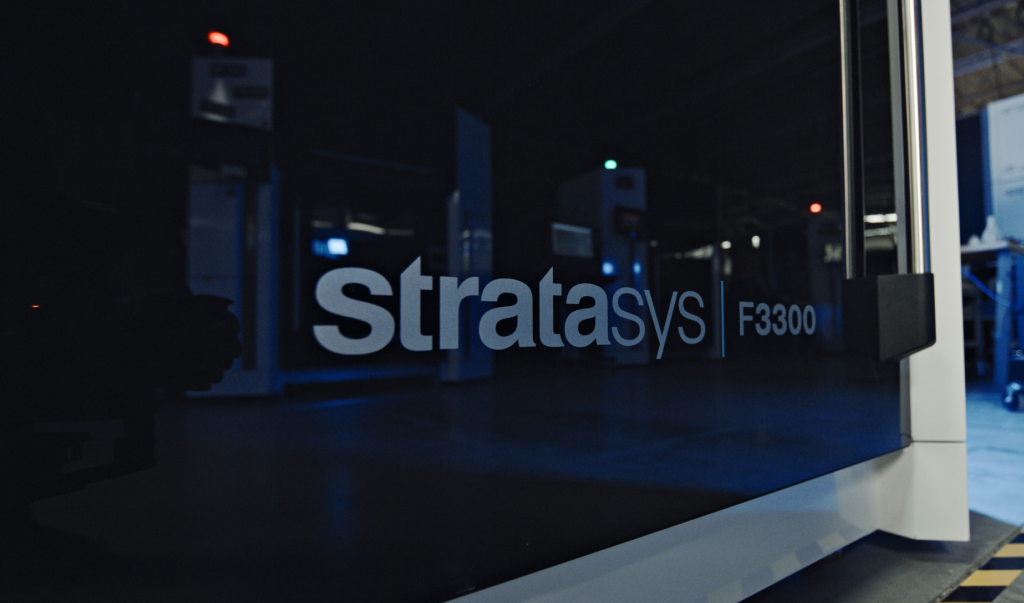At Formnext 2023, we had the opportunity to speak with the Chief Industrial Business Officer of Stratasys (Nasdaq: SSYS), Rich Garrity. Having previously served as President of Stratasys Americas and overseer of the company’s industrial portfolio, Garrity now finds himself at the heart of a pivotal moment for Stratasys, surrounded by discussions of mergers. Amid these speculations, the question arises: will Stratasys stand independently or chart a new path? Despite the tumultuous backdrop, Garrity appeared relaxed and content, engaging with his peers at Formnext.
Garrity was particularly enthusiastic about introducing the new F3300 3D printer. This industrial-grade machine marks a significant advancement with double the printing speed of its predecessors and introduces several innovations. It features a novel spool size, tool changers, and a new filament diameter. The system’s 600 mm x 600 mm x 800 mm build volume represents a significant engineering shift for Stratasys, as well.
“The new system is meant for aerospace, industrial, and similar markets. Ultimately, we’re looking to get FDM more into production. To do that, we have to get cost per part down. It’s a faster printer but it also has more uptime, more redundancy, and part quality. You can run the system all weekend with automated spool changes. You can run different nozzles with a thick bead for the inside and a thin one for the outside to save time. That, together with new spools and an architecture, helps us reduce part cost,” Garrity said.
With these advancements in the F3300, it naturally raises a critical question regarding its position within Stratasys’ existing lineup, particularly in relation to the Fortus F900 series and other printers.
“The F3300 is a future platform for other systems. This is the vision of where it’s going to go. We will also go much larger and bigger. Think of drone components, panels, tooling, and defense parts. We are going to continue to inject value into the 900; the 900 is not going away. We are introducing new materials for the 900, for example, such as flame-retardant ones from Kimya. The 900 is for services and functional prototypes.”
Stratasys has more recently become known for its diverse technological portfolio, including fused deposition modeling (FDM), PolyJet, polymer powder bed fusion via what the company calls “selective absorption fusion (SAF)“, and vat polymerization through both stereolithography (SLA) and digital light processing (DLP). This raises the question: Will these technologies collectively advance towards production-oriented applications?
“Lately, we’ve seen the momentum pick up with SAF. This is due to a couple of reasons: one is reliability and productivity improvements in the systems, software improvements, and the availability of PA 12. These are coming together to accelerate SAF in automotive, healthcare, and orthotics. We are also seeing potential in aligners. Customers are ordering their second SAF machines. With stereolithography and the NEO systems, we see movement in traditional automotive applications. The P3 technology and Origin systems are also seeing new materials, printers, and software. We expect Programmable PhotoPolymerization (P3) and the Origin systems to really move markets. Volume production in connectors, for example, but also in medical.”
Stratasys’s SAF technology features the use of a counter-rotating roller, which coats powder layers onto the print bed and applies absorber fluid, which images the part layers. These imaged layers are then fused together when an infrared (IR) lamp is passed over the whole print bed. Image courtesy of Dyemansion.
Over a decade ago, Stratasys was an FDM-only company. However, the firm gradually expanded its repertoire, incorporating a variety of other systems into its service offerings. This expansion accelerated following its merger with Objet, which introduced SLA, DLP, and SAF technologies. Recently, Stratasys has been fine-tuning its market approach, tailoring more specific solutions for distinct customer segments. Alongside its hardware developments, the company has been progressively building a suite of software solutions, notably centered around GrabCAD and including tools like the OpenAM software package. This package allows users to customize variables and materials on the Fortus F450 FDM system. Significantly, Stratasys is broadening its horizons with an increased range of materials for its FDM systems and forming material partnerships. The acquisition of Covestro further bolstered its capacity to produce and sell its own materials, while still attracting other material firms to its platform.
With the introduction of the new architecture for FDM via the 3300, Stratasys now boasts a diverse array of technologies and machines. Can the company effectively develop all these technologies simultaneously?
Considering that SLA and the Fortus 900 platform continue serving high-mix, low-volume customers effectively, these technologies will require continuous investment and nurturing to maintain existing revenue streams. Concurrently, PolyJet technology is being further segmented to address a wide range of customer needs. Meanwhile, the Origin One DLP machine and the F3300 are being positioned for industrial customers. Achieving this balance is challenging, as it necessitates the development of multiple platforms for vastly different customer bases. There’s a risk, akin to the Nokia scenario, where a diverse portfolio is eclipsed by a single, more specialized or lower-cost competitor – much like the iPhone’s disruptive impact on the mobile phone market. If Stratasys manages to fend off such challengers, it could leverage its global presence and extensive reseller network to market its machines broadly and cross-sell other products to existing clients. Such reach, scale, and scope could position Stratasys for considerable future growth.
